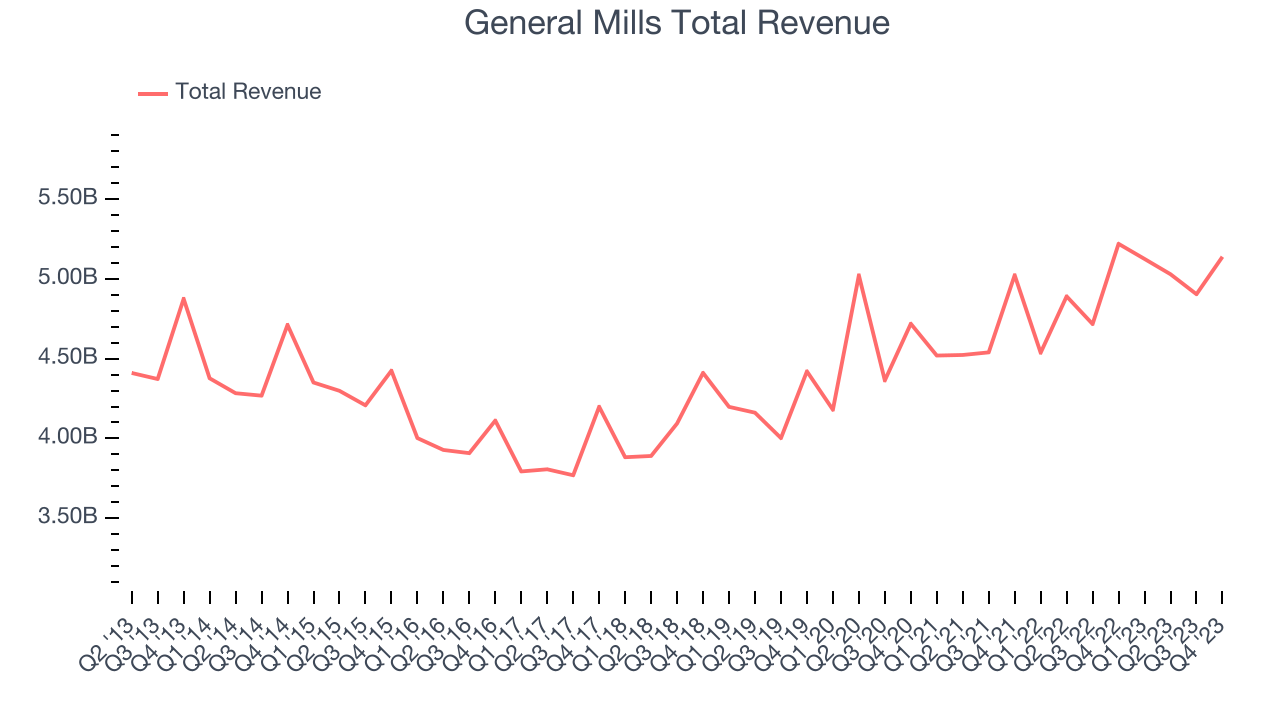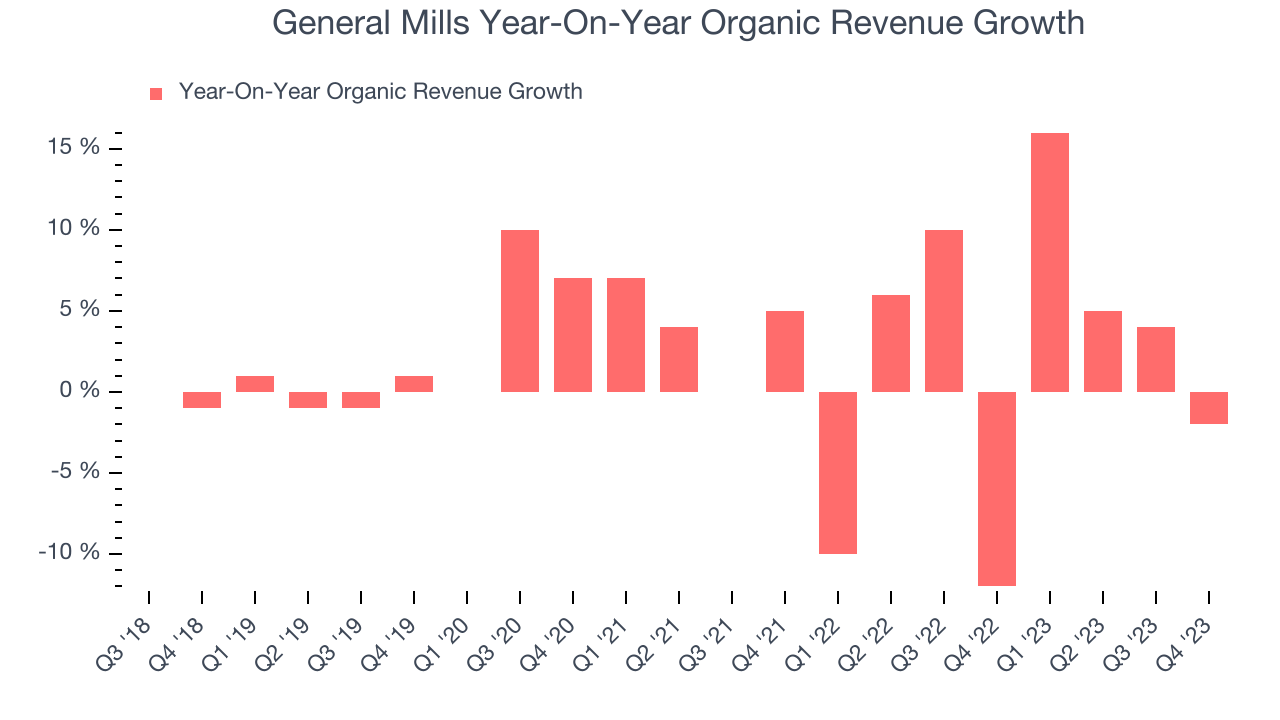Packaged foods company General Mills (NYSE:GIS) fell short of analysts' expectations in Q2 FY2024, with revenue down 1.6% year on year to $5.14 billion. It made a non-GAAP profit of $1.25 per share, improving from its profit of $1.10 per share in the same quarter last year.
Key Takeaways from General Mills's Q2 Results
Volume growth, organic revenue growth, and total revenue all missed. Margins were better, leading to an EPS beat. However, the company lowered its full year revenue outlook based on a "slower volume recovery". The results could have been better and the stock is down 1% on the results and currently trades at $66 per share.
Is now the time to buy General Mills? Find out by accessing our full research report, it's free.
General Mills (GIS) Q2 FY2024 Highlights:
- Market Capitalization: $38.78 billion
- Revenue: $5.14 billion vs analyst estimates of $5.36 billion (4.1% miss)
- EPS (non-GAAP): $1.25 vs analyst estimates of $1.16 (7.9% beat)
- Free Cash Flow of $965.5 million, up from $236.4 million in the previous quarter
- Gross Margin (GAAP): 34.4%, up from 32.7% in the same quarter last year
- Organic Revenue was down 2% year on year (miss vs. expectations of up 2.1% year on year)
- Sales Volumes were down 4% year on year (miss vs. expectations of down 1.8% year on year)
- Guidance lowered: "Organic net sales are now expected to range between down 1 percent and flat, compared to the previous range of 3 to 4 percent growth, reflecting a slower volume recovery in fiscal 2024"
“While we saw a slower-than-expected volume recovery in the second quarter amid a continued challenging consumer landscape, we generated bottom-line growth thanks primarily to strong HMM cost savings,” said General Mills Chairman and Chief Executive Officer Jeff Harmening.
Best known for its portfolio of powerhouse breakfast cereal brands, General Mills (NYSE:GIS) is a packaged foods company that has also made a mark in cereals, baking products, and snacks.
Packaged Food
As America industrialized and moved away from an agricultural economy, people faced more demands on their time. Packaged foods emerged as a solution offering convenience to the evolving American family, whether it be canned goods, prepared meals, or snacks. Today, Americans seek brands that are high in quality, reliable, and reasonably priced. Furthermore, there's a growing emphasis on health-conscious and sustainable food options. Packaged food stocks are considered resilient investments. People always need to eat, so these companies can enjoy consistent demand as long as they stay on top of changing consumer preferences. The industry spans from multinational corporations to smaller specialized firms and is subject to food safety and labeling regulations.
Sales Growth
General Mills is one of the most widely recognized consumer staples companies in the world. Its influence over consumers gives it extremely high negotiating leverage with distributors, enabling it to pick and choose where it sells its products (a luxury many don't have).
As you can see below, the company's annualized revenue growth rate of 3.4% over the last three years was mediocre as consumers bought less of its products. We'll explore what this means in the "Volume Growth" section.

This quarter, General Mills missed Wall Street's estimates and reported a rather uninspiring 1.6% year-on-year revenue decline, generating $5.14 billion in revenue. Looking ahead, Wall Street expects sales to grow 2.8% over the next 12 months, an acceleration from this quarter.
Our recent pick has been a big winner, and the stock is up more than 2,000% since the IPO a decade ago. If you didn’t buy then, you have another chance today. The business is much less risky now than it was in the years after going public. The company is a clear market leader in a huge, growing $200 billion market. Its $7 billion of revenue only scratches the surface. Its products are mission critical. Virtually no customers ever left the company. You can find it on our platform for free.
Organic Revenue Growth
When analyzing revenue growth, we care most about organic revenue growth. This metric captures a business's performance excluding the impacts of foreign currency fluctuations and one-time events such as mergers, acquisitions, and divestitures.
The demand for General Mills's products has been stable over the last eight quarters but fallen behind the broader sector. On average, the company has posted feeble year-on-year organic revenue growth of 2.1%. 
In the latest quarter, General Mills's organic sales fell 2% year on year. This decrease was an improvement from the 12% year-on-year decline it posted 12 months ago. It's always great to see a business improve its prospects.
General Mills may not have had the best quarter, but does that create an opportunity to invest right now? When making that decision, it's important to consider its valuation, business qualities, as well as what has happened in the latest quarter. We cover that in our actionable full research report which you can read here, it's free.
One way to find opportunities in the market is to watch for generational shifts in the economy. Almost every company is slowly finding itself becoming a technology company and facing cybersecurity risks and as a result, the demand for cloud-native cybersecurity is skyrocketing. This company is leading a massive technological shift in the industry and with revenue growth of 50% year on year and best-in-class SaaS metrics it should definitely be on your radar.
Join Paid Stock Investor Research
Help us make StockStory more helpful to investors like yourself. Join our paid user research session and receive a $50 Amazon gift card for your opinions. Sign up here.
